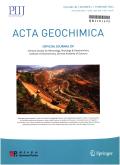Long-term hydrochemical monitoring and geothermometry: understanding groundwater salinization and thermal fluid contamination in Mila’s basin, Northeastern Algeria
Abstract
The regular hydrochemical monitoring of groundwater in the Mila basin over an extended period has provided valuable insights into the origin of dissolved salts and the hydrogeochemical processes controlling water salinization. The data reveals that the shallow Karst aquifer shows an increase in TDS of 162 mg L−1 while the thermal carbonate aquifer that is also used for drinking water supply exhibits an increase of 178 mg L−1. Additionally, significant temperature variations are recorded at the surface in the shallow aquifers and the waters are carbogaseous. Analysis of dissolved major and minor elements has identified several processes influencing the chemical composition namely: dissolution of evaporitic minerals, reduction of sulphates, congruent and incongruent carbonates’ dissolution, dedolomitization and silicates’ weathering. The hydrogeochemical and geothermometric results show a mixing of saline thermal water with recharge water of meteoric origin. Two main geothermal fields have been identified, a partially evolved water reservoir and a water reservoir whose fluid interacts with sulphuric acid (H2S) of magmatic origin. These hot waters that are characterized by a strong hydrothermal alteration do ascend through faults and fractures and contribute to the contamination of shallower aquifers. Understanding the geothermometry and the hydrogeochemistry of waters is crucial for managing and protecting the quality of groundwater resources in the Mila basin, in order to ensure sustainable water supply for the region. A conceptual model for groundwater circulation and mineralization acquisition has been established to further enhance understanding in this regard.

 求助内容:
求助内容: 应助结果提醒方式:
应助结果提醒方式:


